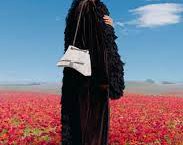Luxury brands are turning to influencers who do not have obvious links with fashion. Social media creators who have built authentic communities can add value-laden credibility. [The business of influence: New voices force a fashion marketing rethink – Vogue]
What do a rapper, a volleyball player and a fashion model have in common? They’ve all been deemed worthy ambassadors by Balenciaga, which featured Big Matthew, Kim Yeon-Koung and Khadim Sock in its Autumn/Winter 2022 campaign. Back in June, equally unexpectedly, the brand released a campaign promoting its BB monogram featuring techno-symphonic composer Bfrnd and edgy Lab Store buyer Kat Zhang.
Could this be the way forward for luxury fashion marketing? As Vogue Business reported in part four of this series, brands have become more interested in signing partnerships with individuals who have authentically built a community around their skills and interests — rather than celebrity or macro influencers who may be struggling to connect with their audiences.
An even fresher set of creators is emerging. They have built followings on new generation social media platforms such as TikTok, Discord, Twitch and even Patreon, all of which have gained traction among millennial and Gen Z users in recent years. Many of these personalities specialise in gaming, comedy and music; their rise to fame catching the eye of fashion and beauty brands.
Nic Kaufmann, who uses his social media platform to tackle gender stereotypes and promote multiculturalism, showed up in head-to-toe Dior at the luxury house’s show in London in December 2021. Khaby Lame, a Senegalese-Italian creator who makes TikTok videos mocking overly complicated life hacks, is now the face of Hugo Boss, while English train enthusiast Francis Bourgeois has fronted campaigns for The North Face and Gucci campaign and attended Gucci shows.
Partnerships with TikTok creators offer rich potential, enabling brands to tap into the playful remix culture that runs through social media, says Harvey Cossell, chief strategy officer at creative agency We Are Social. However, brands will have to think creatively about how they can partner with these niche creators. At first sight, they may not always appear a perfect match for brands in terms of their personal aesthetic or the nature of their content — previously considered essential attributes for the image-driven fashion and beauty industries.
Jewellery brand Pandora, for example, usually features models with beautifully manicured nails wearing its rings and bracelets in ad campaigns. In 2021 it entered into partnerships with some unexpected creators on Twitch who promoted the brand while livestreaming themselves playing video games. YSL Beauty, Carolina Herrera, Calvin Klein and American Eagle have also sponsored streams on the platform. YSL Beauty’s initiative, which brought together three popular female gamers to solve a series of challenges with their communities live on Twitch, drew over 465,000 unique viewers, according to the platform.
“There has been a shift over the past couple of years in the type of influencers that fashion brands are working with — that could be in response to [the brands] beginning to lose cultural connection to their audiences,” says Cossell. Shared values between brands and consumers now matter hugely. Brands need to display themselves as tastemakers, as part of the culture. Partnerships with hot — and relevant — talent are a means to that end, building cachet and tapping the zeitgeist.
“Brands are looking at influencers that have something to say beyond the aesthetic,” says Cossell. “This marks a clear departure from the ‘it girl’ front rows of fashion.” He cites as an example Jay-Ann Lopez, founder of Black Girls Gamers, a multi-platform LGBTQ+ community of over 8,000 black women who share a passion for gaming. She’s signed partnerships with accessories label Kurt Geiger and contemporary womenswear brand Borgo de Nor.
Amy-Lee Cowey, vice president of global creative and digital strategy at Karla Otto, observes that more brands are opting for influencers who aren’t necessarily in the same niche because “it tends to generate wider interest from a broader group of people, including those who wouldn’t pay as much interest to a more traditional fashion influencer campaign". She adds: "Fashion is a very personal matter for everyone; just because an influencer doesn’t label themselves a style influencer, it doesn’t mean their audiences aren’t interested in fashion at all. It isn’t that binary.”
TikTok and algorithms
Definitions of what makes great content have evolved. The rise of TikTok has drawn users away from long-form content pioneered by blogs, and keeping in touch with friends and family, in favour of scrolls of video clips created by amateurs. Platforms such as messaging platform Discord and subscription-based Patreon encourage users to engage beyond visual means.
Most of the new creators that Karla Otto’s brands are partnering with are from TikTok, says Cowey. “That’s where we’re seeing a huge rise in lo-fi, less edited and more authentic content.” TikTok users enjoy engaging with the unpredictable, making them attractive for brand partners, she adds. “The more unconventional the creator or the theme of the video, the higher the chance of gaining better reach.”
The most popular creators of today tap into one or more of three categories. Firstly, entertainment — they’re enjoyable to watch. Secondly, education — they’re informative and good at teaching. Thirdly, celebrity — but, importantly, in this category they retain a sense of relatability through the so-called “Facetime effect” of interacting with audiences in real time.
The breadth of platforms available today allows new creators to pop up and gain virality on a daily basis, says Hugo Ramos, brand analyst at influencer marketing platform Lefty. In what he terms “a constant reshuffle of talent”, as younger creators enter the market, mature influencers may step away from content creation to develop other entrepreneurial projects. That’s a natural progression, says Ramos.
The pace induced by the algorithms of modern-day apps is speeding up the lifecycles of influencers. “If you look at the top five profiles on Instagram right now, most of these users have had a bump in followers or engagement recently. Some of them were not really known before May, but maybe they made a post that caught everyone’s attention,” says Ramos. “One influencer had an increase of 71,000 followers in only three months, which is incredible.”
What does that mean for costs? "Fashion and beauty influencers tend to be on the higher end of the budget spectrum, especially if they are well known. They are both broad areas of interest that attract mass awareness on a very global scale," says Karla Otto’s Cowey. Deciding whether to partner with a traditional influencer or a niche alternative creator comes down to the end goal. “Utilising an influencer from another industry just to cut costs isn’t the best strategy.”
Making an impact on Patreon
The top creators on Patreon — a membership platform that allows content creators to charge for a subscription, which was founded in 2013 — have effectively built and sustained audiences, no matter what the topic, says Sarah Penna, senior manager of creator launches on Patreon. The platform counts over 250,000 active creators earning a collective total of over $3.5 billion directly from their patrons (subscribers). “We’ve seen podcasts with barely any social media presence do very well on Patreon because [the people behind them] have built a parasocial relationship with their fans, and a percentage of those fans will follow them anywhere.”
Creators can be platform-agnostic if they intensely understand their audience base and are able to personalise their content and give value to fans, she says. There is no single top performing content format, she observes. Top creators on Patreon offer an array of subscriber-exclusive content and access, including audio, video, voting power, early access to content or merch, teasers and opportunities for audiences to engage via live streams or Q&As. The best make serious money: Patreon account RedHanded, founded by UK-based Hannah Maguire and Suruthi Bala, has over 10,500 subscribers, earning them £54,000 a month.
Patreon recently released its first Creator Census survey, which gathered data from over 13,000 earning creators across 113 countries. The survey, which also measured the most popular verticals, demonstrated a wealth of diversity among creators and “a wide range of communities”, says Penna. Top creative mediums included video, writing, audio, visual arts, gaming and photography.
A richness of subject matter can be seen across many social platforms. The fastest-growing creators on TikTok cover topics such as property investment, drywall installations, survival, fitness and forest-cabin living. The fastest-growing creators on YouTube often centre their content on comedy or wellbeing — most have utilised the new Shorts feature (some claim it’s an easier tool for driving revenue than TikTok and Instagram Reels).
For many brands, Instagram is now facing true competition. “It stands to reason that brands in one category will look beyond their existing community for growth,” says We Are Social’s Cossell. “The opportunity that creators afford brands is the chance to embed themselves in new communities, as long as the influencer shares the brand’s values.”
These platforms can also help shape a future where there is less tolerance for prejudice, stereotypes and labelling, says Karla Otto’s Cowey, pointing to platforms like Discord and Roblox, where anonymity and engaging behind virtual names or avatars is the norm, and Twitch and TikTok, where self-expression and individualism are encouraged. Although, “as these platforms are still new in the influencer marketing industry at large, it’s hard to tell how much of a real impact it has made on diversity,” she says.
A recent YouTube Culture and Trends Report identified “a new age of creators”, where “interactive audiences” seek connection through content. Now’s the time, says Cossell, for brands “to delve into niche communities… and demonstrate to younger consumers that they are more multifaceted than they might have thought.”



